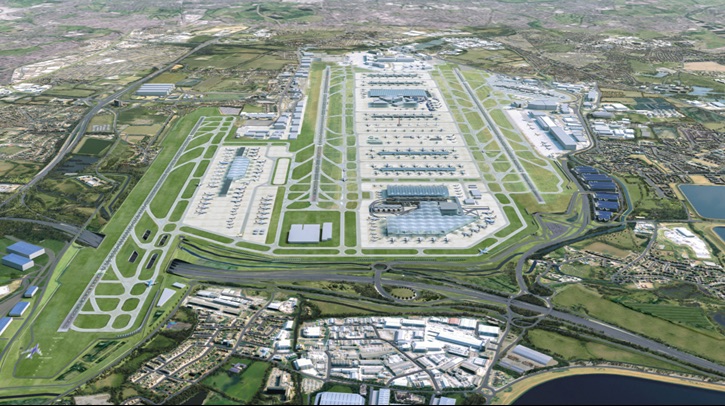London Heathrow Airport has submitted its proposals for a brand-new terminal ‘T5X’, the expansion of Terminal 2 and three new satellite terminals – as well as a 100% privately financed third runway.
Investment proposal
The £49bn investment consists of three main elements: £21bn (US$27bn) for the new runway and airfield infrastructure (up from £14bn in 2018 due to construction inflation); £12bn (US$16bn) for new terminal and stand capacity – the brand new T5X; and £15bn (US$20bn) to modernize the current airport by expanding Terminal 2 and ultimately closing Terminal 3. The blueprint details a north-western runway up to 3,500m, and increased capacity to accommodate up to 756,000 flights and 150m passengers.
According to the airport, a third runway and supporting infrastructure could be ready within a decade, with the full investment across all terminals taking place over the coming decades.
A new road tunnel and plans for two dedicated parkways and improvements to the country’s busiest bus and coach station have also been proposed. Heathrow’s proposals include more choice and capacity on public transportation, such as enhanced rail capacity and walking and cycling routes, reducing local and environmental impacts.
Advantages
The airport says the expansion would add approximately 30 extra daily domestic routes connections and a better selection of flight times to the most popular destinations. Terminals will be more spacious and accessible, and the once-in-a-generation redesign of the airfield will enable flights to take off more quickly.
Once completed, Heathrow’s plans are projected to grow the UK economy by 0.43% GDP, adding 50% capacity to the country’s most valuable trading port – already enabling more than £200bn (US$260bn) of annual trade. Expanding Heathrow is expected to deliver new long-haul routes to growing economies and increase cargo capacity by 50%, expanding trading opportunities for businesses of all sizes.
Local employment
The airport has highlighted the tens of thousands of employment opportunities during design, construction and operation. Meanwhile 60% of the wider supply chain spend will go to companies outside London and the South-East. A community fund is being proposed for the airport’s nearest neighbors.
Thomas Woldbye, CEO of Heathrow, said, “It has never been more important or urgent to expand Heathrow. We are effectively operating at capacity to the detriment of trade and connectivity. With a green light from government and the correct policy support underpinned by a fit-for-purpose regulatory model, we are ready to mobilize and start investing this year in our supply chain across the country. We are uniquely placed to do this for the country; it is time to clear the way for take-off.”
Next steps
If the UK government implements the necessary policy changes, Heathrow will consult with airlines, the local community, local authorities, businesses and others from next year. A planning application is expected to be submitted in 2028.
The Confederation of British Industry, British Chambers of Commerce, Make UK, Federation of Small Businesses and Institute of Directors, stated, “The UK business community supports the expansion of Heathrow with a third runway – an investment in the nation’s future. The benefits are clear: for exporters, it opens up vital access to major and emerging markets; for visitors, it enhances global and domestic connectivity; and for businesses, it unlocks billions in private investment, strengthening supply chains, creating jobs and driving skills across the country.”
Kenton Jarvis, CEO of easyJet, added, “Expansion at Heathrow will provide consumer and economic benefits and represents a unique opportunity for easyJet to operate from the airport at scale for the first time and bring with it lower fares for consumers.”
Sustainable growth
With this proposal, Heathrow has confirmed its commitment to reach net zero by 2050 and set targets on noise reduction and air quality. So far, the airport has cut 10% of its carbon from flights since 2019, and 15% of its carbon emissions on the ground. It has plans to further ramp up its world leadership on the use of sustainable aviation fuel (SAF).
Heathrow’s noise footprint has also reduced by 41% since 2006 and all air quality monitors around the airport are meeting limits. A third runway and redesigned airspace will give communities and passengers more certainty and reliability on flight paths.
In related news, the National Energy System Operator (NESO) recently published its final report from the review into the North Hyde Substation outage and fire that closed Heathrow Airport in March of this year

